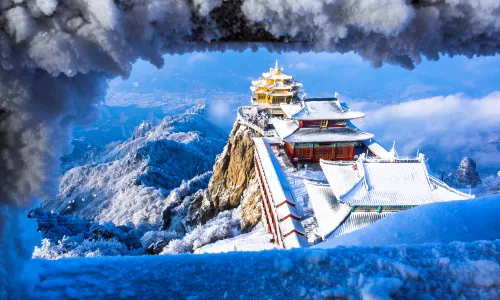
- 4.7/5
 何乐95
何乐95Well, I can understand having a large number of people, as that's beyond human control. But the sightseeing buses are truly baffling. Their usual money-grabbing tactics significantly diminish the experience. They insist on building parking lots all the way there and then having the buses transport them. This makes such a famous tourist attraction feel incredibly inadequate (don't say things like "since you're already there, just have fun," tourism is a comprehensive experience). In this respect, the attractions in Kaifeng are much better.
- 4.7/5
 M57***62
M57***62The scenery is beautiful, but the restrooms in the scenic area are terrible. Management is inadequate, and the ticket sellers at the windows have poor service. If the restrooms and safety measures in the scenic area could be improved, it would be perfect.
- 4.7/5
 Anonymous user
Anonymous userThe Luoyang Museum is an absolute underrated treasure! As a concentrated essence of the ancient capital of thirteen dynasties, it tells the story of the "Divine Capital's" glory in the most direct way. The unearthed Northern Wei clay Buddha face, though incomplete, possesses a serene and compassionate beauty that touches the soul—a "Mona Lisa of the East." Be sure to allocate at least 3 hours; the exhibits are incredibly informative! If you are a history enthusiast, this is paradise; if you are just passing through, it is enough to plant a seed of wonder in your heart—that the pulse of Chinese civilization once beat so powerfully here.
- 4.6/5
 清风过少年
清风过少年Baima Temple truly deserves its reputation as China's oldest temple. Ancient cypress trees, some over a thousand years old, shade the red walls, and the chanting of Buddhist hymns seems to transcend time. There's no bustling commercialism, only a serene Zen atmosphere and a profound sense of history. Walking on the stone steps of Qingliang Terrace, watching the incense smoke rise, one can almost hear the echoes of camel bells from the Eastern Han Dynasty. A short two-hour visit felt like stepping into another world. This solemnity, passed down for millennia, commands utmost respect.
- 4.3/5
 lin***ie
lin***ieThe park is very large and has a Han and Tang Dynasty style. The night views of Mingtang Paradise and Yingtian Gate are charming, and the Yingtian Gate light show is worth seeing. The martial arts field experience project at Jiuzhou Pond has a good design and is suitable for going at night. It is too hot during the day.
- 4.5/5
 M25***57
M25***57Overall it was pretty good, just too tiring. The digital museum had a place to sit and there was a performance, but it was probably too late, so not many people stayed; almost everyone left by the time the performance started.
- 4.5/5
 大胖耐
大胖耐The peonies in the National Flower Garden are very beautiful. The garden is not too big. We took a sightseeing bus. When we went there early in the morning, we could see the peonies in full bloom. They were very beautiful. In the afternoon, the flowers might have wilted a little.
- 4.7/5
 M11***30
M11***30The environment was great, and the museum was huge. The guide led us through all the exhibits, and her explanations were excellent. Not only were there many exhibits, but the legendary ancient tomb artifacts were also truly impressive. Most importantly, there were few people, so we could explore at our own pace – that's better than anything else!
- 4.2/5
 跌落凡间的🐱
跌落凡间的🐱Since admission is free, let's not discuss the value for money. Let's discuss the history of Luoyi Ancient City. The origins of Luoyi Ancient City date back to the Western Zhou Dynasty. After King Wu of Zhou conquered the Shang Dynasty, he planned to build a new capital in the Yi and Luo regions to consolidate his rule in the east. After Duke Zhou quelled the rebellion of the Three Guards, construction of Luoyi began in the fifth year of King Cheng's reign. Duke Zhao selected the site, and Duke Zhou oversaw the construction, completing the city in about a year. After its completion, Luoyi became the Eastern Capital of the Western Zhou Dynasty. It consisted of the Royal City and Chengzhou. The Royal City, located east of the Jian River and west of the Chan River, served as the place where princes met with the king and where the Western Zhou nobles resided. Chengzhou, located east of the Chan River, housed the military and settled the people of Yin. Since then, Luoyang has remained one of China's political centers, flourishing through multiple dynasties. The current Luoyi Ancient City is a comprehensive historical and cultural ancient city built on the basis of the original historical sites, with the architectural styles of the Tang, Song, Yuan, Ming and Qing dynasties as the main tone. It has preserved the protected buildings of many historical periods, such as the Henan Prefecture Confucian Temple, Tuling Palace, Four-Eyed Well, and the ruins of the ancient city wall of Jin and Yuan Dynasties.
- 4.6/5
 wR8023
wR8023The peonies were absolutely gorgeous!! The first time I went, the flowers weren't in bloom yet, so I went back a month later specifically to see them! There were many varieties, and I even saw the silver thread peonies. The queue was very long, but it was worth it.







 See the snow at Longmen for a limited time, and find yourself in nature | Dec 2025-Jan 2026
See the snow at Longmen for a limited time, and find yourself in nature | Dec 2025-Jan 2026 Achieved a 3-year streak on the annual lists
Achieved a 3-year streak on the annual lists









